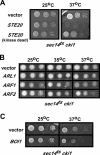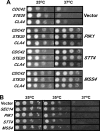Regulation of phosphoinositide levels by the phospholipid transfer protein Sec14p controls Cdc42p/p21-activated kinase-mediated cell cycle progression at cytokinesis
- PMID: 17601877
- PMCID: PMC2043397
- DOI: 10.1128/EC.00087-07
Regulation of phosphoinositide levels by the phospholipid transfer protein Sec14p controls Cdc42p/p21-activated kinase-mediated cell cycle progression at cytokinesis
Abstract
Sec14p is an essential phosphatidylcholine/phosphatidylinositol transfer protein with a well-described role in the regulation of Golgi apparatus-derived vesicular transport in yeast. Inactivation of the CDP-choline pathway for phosphatidylcholine synthesis allows cells to survive in the absence of Sec14p function through restoration of Golgi vesicular transport capability. In this study, Saccharomyces cerevisiae cells containing a SEC14 temperature-sensitive allele along with an inactivated CDP-choline pathway were transformed with a high-copy-number yeast genomic library. Genes whose increased expression inhibited cell growth in the absence of Sec14p function were identified. Increasing levels of the Rho GTPase Cdc42p and its direct effector kinases Cla4p and Ste20p prevented the growth of cells lacking Sec14p and CDP-choline pathway function. Growth suppression was accompanied by an increase in large and multiply budded cells. This effect on polarized cell growth did not appear to be due to an inability to establish cell polarity, since both the actin cytoskeleton and localization of the septin Cdc12p were unaffected by increased expression of Cdc42p, Cla4p, or Ste20p. Nuclei were present in both the mother cell and the emerging bud, consistent with Sec14p regulation of the cell cycle subsequent to anaphase but prior to cytokinesis/septum breakdown. Increased expression of phosphatidylinositol 4-kinases and phosphatidylinositol 4-phosphate 5-kinase prevented growth arrest by CDC42, CLA4, or STE20 upon inactivation of Sec14p function. Sec14p regulation of phosphoinositide levels affects cytokinesis at the level of the Cdc42p/Cla4p/Ste20p signaling cascade.
Figures







References
-
- Aravind, L., A. F. Neuwald, and C. P. Ponting. 1999. Sec14p-like domains in NF1 and Dbl-like proteins indicate lipid regulation of Ras and Rho signaling. Curr. Biol. 9:R195-R197. - PubMed
-
- Bankaitis, V. A., J. R. Aitken, A. E. Cleves, and W. Dowhan. 1990. An essential role for a phospholipid transfer protein in yeast Golgi function. Nature 347:561-562. - PubMed
-
- Bankaitis, V. A., S. Phillips, L. Yanagisawa, X. Li, S. Routt, and Z. Xie. 2005. Phosphatidylinositol transfer protein function in the yeast Saccharomyces cerevisiae. Adv. Enzyme Regul. 45:155-170. - PubMed
Publication types
MeSH terms
Substances
Grants and funding
LinkOut - more resources
Full Text Sources
Molecular Biology Databases
Miscellaneous

